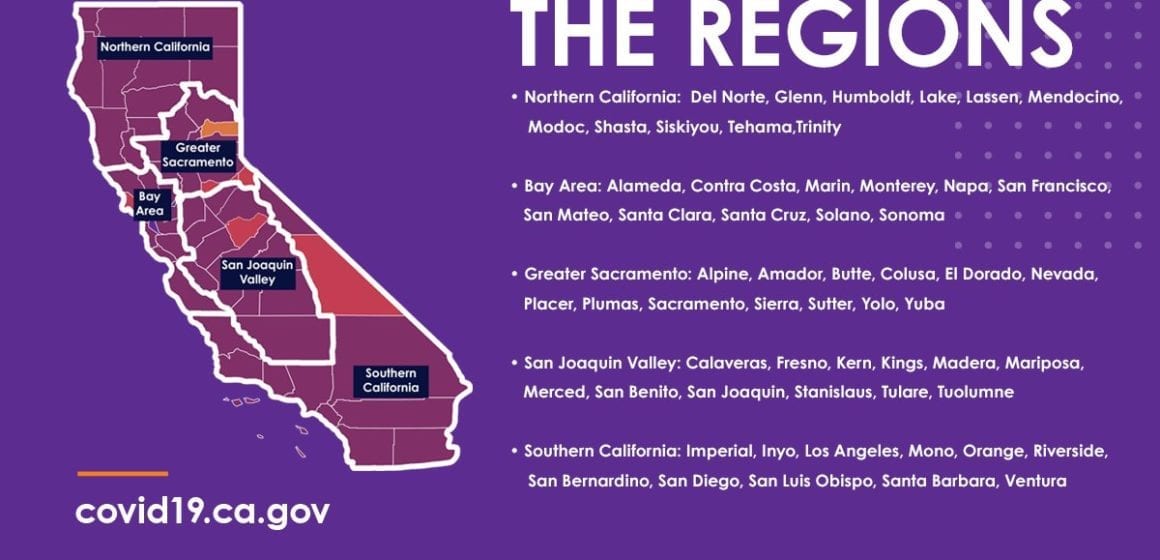Health officials around the Bay Area accelerated a stay-at-home order that starts this weekend for most of the region, including Santa Clara County.
The order goes into effect at 10 p.m. Dec. 6 and lasts until Jan. 4. It enacts the same restrictions as the state order, requiring all nonessential operations to shut down with the exception of retail.
Santa Clara County Health Officer Dr. Sara Cody said none of the counties in the Bay Area is an island and that each must unite in a regional response.
“The surge and COVID-19 patients needing hospitalizations has struck Santa Clara County first,” Cody said. “But we know that our region and surrounding jurisdictions are soon to follow and indeed are already experiencing the surge.”
The move comes after Gov. Gavin Newsom announced the state would impose regional stay-at-home orders for areas where intensive care unit (ICU) availability falls to 15%.
Despite Bay Area ICU capacity not dropping to 15%, local health officials said they are taking action before COVID-19 overburdens hospitals.
“We cannot wait until after we have driven off the cliff to pull the emergency brake,” said Cody. “We understand that the closures under the state order will have a profound impact on our local businesses. However, if we act quickly, we can both save lives and reduce the amount of time these restrictions have to stay in place, allowing businesses and activities to reopen sooner.”

Under the order, barbershops, nail salons, personal care services, movie theaters, museums, bars and wineries must close.
Schools already holding in-person classes with waivers and critical infrastructure can remain open.
Retail can continue doing business at 20% capacity and restaurants can only serve take-out and delivery — shuttering outdoor and indoor dining. Santa Clara County has already closed indoor dining and had limited nonessential retail to 10% capacity, but officials said the county will align with the state in allowing 20% capacity inside retail shops.
People who travel into the county from 150 miles away must quarantine for 14 days.
“I and other health officers in the Bay Area don’t think we can wait,” said Contra Costa County Public Health Officer Dr. Chris Farnitano. “We must act swiftly.”
Santa Clara County joined San Francisco, Marin, Alameda and Contra Costa to act in unison to push ahead with the order.
State health officials project ICU capacity in the Bay Area will fall below 15% in mid-to-late December, unlike other regions which will drop below 15% within the next few days.
But local health officers said hospitals must avoid reaching those levels or otherwise risk overwhelming and infecting their own health care workers.
“The critical resource is staffing, in particular, staff that are trained in critical-care settings,” Cody said. “So, that is one of the many reasons why prevention is the best solution, and to the extent that we can prevent our residents from needing care.”
Reaction in the business community was mixed.
Blossom Nail Spa owner Linda Do said she understands the need for closures but with no government assistance, small businesses will soon close indefinitely.
“They want to shut us down, which is fine for health reasons for the community, but we’re not being helped financially,” Do said. “And we don’t know how much is enough. We don’t know because how long is it going to go on for? They say three weeks but it might go on longer. Who knows?”
She said her employees will be hit the hardest.
“My staff depends on their job … I don’t have answers for them and they’re just devastated because they want to go to work to provide for their family,” she said.
Tina Le, the owner of Nail Elegance in San Jose, said local leaders pulled the brakes too late and put an abrupt burden on local businesses.
“This whole thing is a joke,” she said. “I have no trust in our government right now and I am very angry.”
Juan Castillo, owner of Dapper barbershop near Kelley Park in San Jose, said his business was closed for six months during the first shutdown. After opening in September, he said COVID-19 cases were low for a month but then everything started skyrocketing as people went to restaurants and gyms.
Barbers are trained in sanitation and how to avoid cross-contamination, he said. They do temperature checks and clean stations after every client.
“It’s not fair that barbershops are doing their best but are being closed,” he said. “A client is safer at a barbershop than Costco or Target. We are the ones hurting and we are the ones keeping our businesses clean and hygienic.”
Castillo said if he has to close he won’t be able to pay his rent and might lose the business.
“We have families to feed and this is our only source of income,” he said.
Denise Russell, a hair stylist and owner of Special FX Salon & Day Spa in San Jose, said the ever-changing rules for businesses have been difficult but she understands the need for safety.
“We don’t want people to die,” she said. “If the hospitals are overrun, then I’m all for shutting down.”
Now, nearly 10 months into the pandemic, Russell said her initial shutdown anxieties have been replaced by a sense of calm.
“When this first started I wanted to control it. Now I’m past that and accepting this is where we are,” Russell said. “I am confident my business will survive. I don’t know why I feel like that, I just do.”
Business closures and restrictions under the state’s regional stay-at-home order are described here.
Lorraine Gabbert and Madelyn Reese contributed to this story.
Contact Mauricio La Plante at [email protected] or follow @mslaplantenews on Twitter.



Leave a Reply
You must be logged in to post a comment.